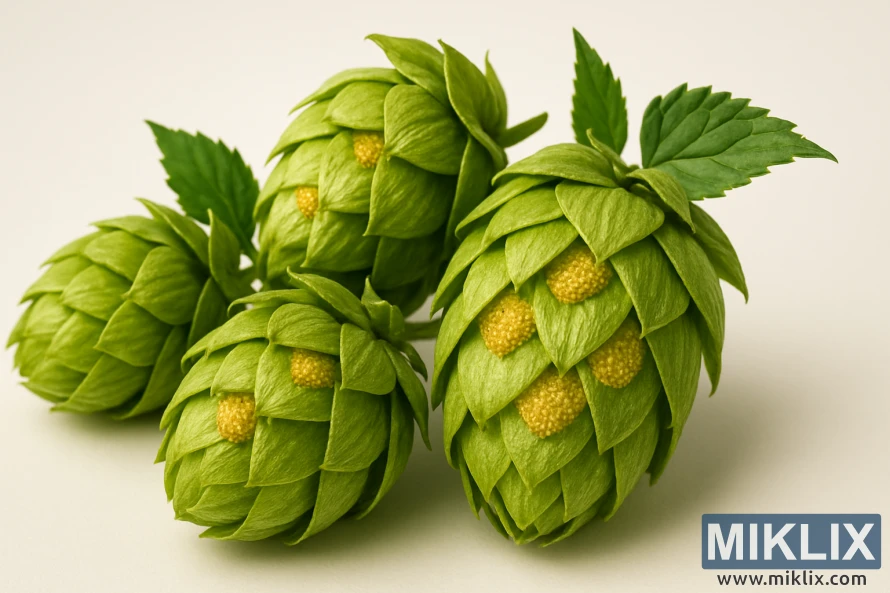Image: Close-Up of Fresh Opal Hop Cones in Studio Lighting
Published: October 27, 2025 at 9:06:24 PM UTC
A high-resolution close-up of vibrant Opal hops, showcasing their lush green cones and golden lupulin glands in a crisp, well-lit studio setting with a minimalist backdrop.
The photograph presents a striking studio composition of freshly harvested Opal hop cones, celebrated for their use in brewing and their unique aromatic qualities. The image is rendered with remarkable clarity and depth, allowing every intricate detail of the hop cones to emerge vividly. Four mature hop cones form the centerpiece of the composition, each displaying its layered structure of overlapping bracts. Their lush, velvety green surfaces glow under the controlled studio lighting, which highlights the cones’ three-dimensional texture. Nestled between the leafy bracts are clusters of lupulin glands, the fine, golden-yellow resinous spheres that carry the essential oils and bittering compounds critical to brewing. These lupulin deposits glisten subtly, their granular surfaces captured in exquisite macro detail, providing a tactile visual sensation that almost conveys their sticky, resinous nature.
The cones themselves are plump, symmetrical, and perfectly formed, showing the characteristic oval-pinecone silhouette typical of the hop plant. Their scales—soft, thin, and papery—layer like shingles on a roof, forming an intricate natural architecture. The surface appears both delicate and robust: delicate in the thinness and subtle curve of each bract, yet robust in the overall conical structure that feels purposeful and protective of the precious lupulin within. The cones are accompanied by sprigs of bright green leaves with sharply serrated edges, which provide a botanical frame and enhance the sense of freshness and vitality.
The lighting of the scene is masterfully executed, striking a balance between precision and warmth. It is diffused yet directional, eliminating harsh shadows while maintaining enough contrast to emphasize the contours and textures of each cone. The warm highlights create a golden glow that accentuates the lupulin, while the gentle shadows between the bracts add dimensionality and depth. The cones appear luminous against the backdrop, which is intentionally minimalist. The background is a soft, clean, off-white tone with a slight cream warmth, designed to recede into neutrality while offering just enough warmth to harmonize with the golden hues of the lupulin. This uncluttered backdrop ensures that the eye is irresistibly drawn to the cones themselves, isolating them as the undisputed subject of the photograph.
The composition as a whole exudes freshness, purity, and natural abundance. It communicates the essence of Opal hops not only as a raw agricultural product but as an object of beauty, crafted by nature with intricate precision. The cones almost feel tangible, inviting the viewer to reach out, touch their papery bracts, and release their delicate, herbal-citrus aroma. The photograph successfully elevates the hop cone—often regarded as a simple brewing ingredient—into a subject worthy of fine art, capturing its scientific intricacy and its aesthetic grace in equal measure. This is not merely a record of hops but a celebration of their form, color, and significance, executed in a manner that reflects both botanical accuracy and artistic refinement.
The image is related to: Hops in Beer Brewing: Opal

